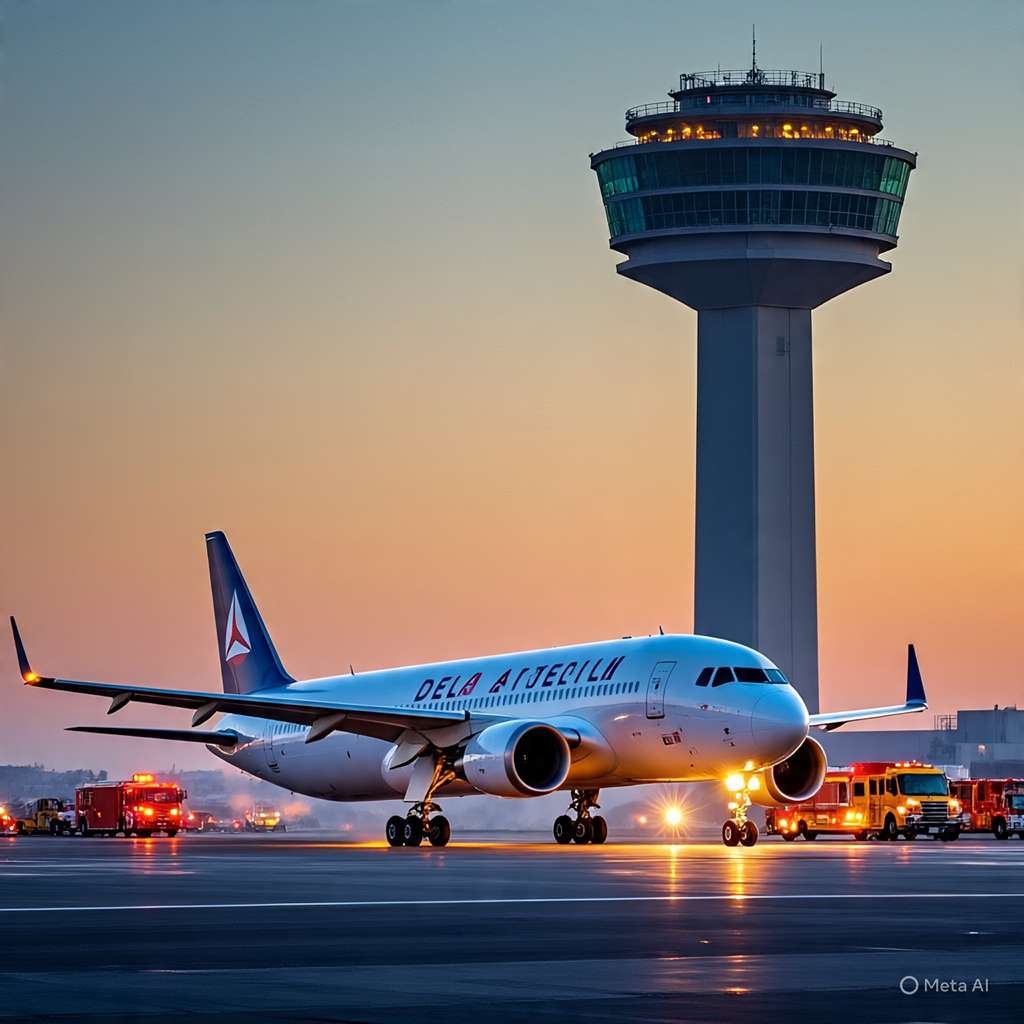
Delta Flight DL275, an Airbus A350 heading from Detroit to Tokyo Haneda, ran into a technical problem with its anti-ice system mid-journey. To keep everyone safe, the pilots made the call to land at Los Angeles International Airport instead. So if you’re searching for delta flight dl275 diverted lax today, the simple reason is safety first no crash drama, just a smart precaution by the crew that kept things under control.
Incident Overview – A Timeline of Events
Delta Flight DL275 started out as a routine long-haul trip, leaving Detroit (DTW) late at night with Tokyo Haneda (HND) as its final stop. The aircraft, an Airbus A350, was cruising over the North Pacific on what should’ve been just another transpacific flight.
Things took a turn when the cockpit received a system alert about the plane’s anti-ice equipment. For most travelers, that might sound minor, but in aviation, any warning tied to ice protection is taken seriously. Ice can mess with engines and sensors at high altitude, and that’s not something you gamble with.
The alert came in a few hours after departure, while the plane was already deep into its route across the ocean. At that point, the pilots had two main options: keep going towards Japan and risk the issue getting worse, or divert to a safe spot with the right maintenance facilities.
Anchorage is often used as an emergency landing point for transpacific flights, but in this case Los Angeles (LAX) made more sense. It had the longer runways, better ground support for an Airbus A350, and access to Delta’s maintenance network. LAX also meant passengers had smoother chances of rebooking onward flights compared to a remote stop in Alaska.
So the decision was made. The crew coordinated with air traffic control, started their diversion procedure, and set course for California. From the outside, it just looked like a change of flight path on radar screens. Inside the cockpit, it was a textbook example of how diversion and emergency landing procedures are supposed to work quick thinking, no panic, just following safety first.
The Technical Issue – Anti-Ice System Failure
So here’s the core of it: the whole drama started because of the plane’s anti-ice system. On big jets like the Airbus A350, these systems keep the engines and wings from building up ice while flying at high altitude. Sounds small, but when you’re cruising over the North Pacific in freezing air, ice is no joke. If it collects on engines, sensors, or even wing edges, it can mess with performance and, in the worst case, cause serious safety issues.
Basically, the anti-ice gear uses hot air bled from the engines or special heating elements to keep critical parts clear. In this case, the sensors noticed the system wasn’t acting the way it should. Think of it like your car flashing a warning light you might keep driving to the next gas station, but if you’re halfway over the ocean with hundreds of people onboard, you don’t take chances.
The cockpit got readings that didn’t match normal operation. Rather than second-guessing or trying to push through, the pilots treated it as a serious failure. That’s exactly how they’re trained. Better to put the jet down somewhere safe with all the right mechanics than risk being hours away from any runway if things got worse.
After the news broke, people jumped online to talk about it. On delta flight dl275 diverted lax reddit threads, passengers and aviation geeks shared what they saw and what they thought happened. Some onboard folks mentioned announcements about a system issue, while others just noticed the plane suddenly making a big turn south. It’s interesting because these communities often pick apart incidents in real time, sometimes even before official reports confirm the details.
Why LAX Was Chosen Instead of Other Airports

When the pilots got that anti-ice warning, they had to make a call fast: where do we land this bird? On transpacific flights, Anchorage is usually the go-to backup because it’s closer to the route. But this time, Los Angeles (LAX) won out and honestly, it made way more sense.
Here’s why:
- Maintenance hub: LAX has Delta’s setup for handling an Airbus A350, plus the right crew for Rolls-Royce Trent engines. Anchorage doesn’t.
- Runways & services: LAX has long runways designed for wide-body aircraft and a fully equipped emergency response team.
- Passenger rebooking: Los Angeles connects to pretty much everywhere. It’s way easier to rebook hundreds of passengers from there compared to Anchorage.
To put it side by side:
| Factor | Los Angeles (LAX) | Anchorage (ANC) |
| Maintenance | Full support for A350 + Rolls-Royce engines | Limited facilities |
| Runways | Multiple long runways, 24/7 services | Long runways, but fewer backup options |
| Passenger options | Easy rebooking to Asia, US, and Europe | Limited onward connections |
| Hub advantage | Major Delta hub | Not a Delta hub |
So yeah, Anchorage was closer, but it’s like breaking down your car would you rather stop at a random mechanic in the middle of nowhere or drive a little longer to a proper service center? Same logic here. LAX just offered everything needed to handle the issue smoothly and get people moving again.
Crew Response and Passenger Experience
The way the crew handled this whole thing honestly showed why training matters so much in aviation. The pilots didn’t panic, didn’t overcomplicate it they saw the warning, talked to air traffic control, and made the call to divert. Quick, calm, and straight to the point. That’s the kind of decision-making that keeps everyone safe.
In the cabin, the flight attendants did their part too. They kept passengers updated without scaring anyone, which isn’t always easy. From what a few travelers later shared online, the announcement was simple: there’s a system issue, we’re landing in Los Angeles, everything’s under control. No drama, no technical overload just clear words so people knew what was happening.
And honestly, most folks stayed pretty relaxed. Some passengers on Reddit mentioned how calm the atmosphere was. Sure, you always have a handful of people stressing about missed connections, but there wasn’t a big sense of fear on board. Instead, it felt more like a detour annoying, yeah, but not life-threatening.
If anything, it was one of those moments where you actually appreciate how professional crews are. Hundreds of people in the air, middle of the night, and the whole diversion felt more like an extra leg of the trip than some emergency. That’s not by accident that’s training, teamwork, and solid communication.
Operational & Financial Impact for Delta
Now, let’s be real a diversion like this doesn’t come cheap. Early estimates put the cost for Delta somewhere around $2.3 million, and that’s not surprising once you break it down.
First, there’s fuel. Rerouting a massive Airbus A350 burns way more than planned, especially when you’re suddenly turning south and flying hours out of your original path. Then you’ve got landing fees at a busy airport like LAX, which definitely aren’t pocket change.
On top of that, Delta had to rebook hundreds of passengers. Some people were put on later flights to Tokyo, others got rerouted through different cities. That meant covering hotel stays, food vouchers, and all the logistics that come with disrupted travel plans.
And don’t forget the ripple effect. When a wide-body aircraft like DL275 gets pulled out of the schedule, it throws off connections across the network. Flights that were supposed to use that same plane get delayed or swapped out, which can snowball into more headaches for both the airline and travelers.
All of this adds up. For passengers, it was just an inconvenience. But for Delta, the operational and financial hit was huge though still better than risking a mid-ocean emergency. At the end of the day, safety first always wins, even if it costs millions.
Predictive Maintenance & What Airlines Can Learn
One of the big takeaways from this diversion is how much airlines still lean on traditional systems. The A350 is packed with high-tech equipment, but even then, things slip through. That’s where predictive maintenance comes in using advanced sensors and real-time data to catch tiny issues before they turn into mid-flight problems.
Think of it like your phone warning you the battery’s about to fail weeks before it actually does. In aviation, predictive analytics can look at engine temperatures, pressure levels, and airflow readings to spot unusual patterns early. If Delta’s system had picked up the anti-ice issue sooner, the plane might’ve been fixed on the ground instead of rerouted over the Pacific.
The future of aviation safety is moving in that direction. Some airlines are already experimenting with AI-driven monitoring that constantly checks engine health. For example, Lufthansa and Singapore Airlines have both tested platforms that send alerts to maintenance crews hours even days before a fault becomes critical. United has also been working on predictive tools for its long-haul fleet, aiming to cut down surprise diversions.
For Delta, and the industry in general, this incident is another reminder that investing in smarter tech isn’t just about saving money. It’s about keeping passengers calm, flights on schedule, and avoiding those multimillion-dollar detours.
Safety Culture in Modern Aviation
If there’s one thing that stands out in aviation, it’s how seriously the industry takes safety. Airlines spend billions making sure planes, crews, and systems are all prepared for situations exactly like this. The whole “safety-first” mindset isn’t just a slogan it’s built into every flight, every checklist, every decision the crew makes mid-air.
This Delta diversion is actually a solid example of how that culture works. The pilots didn’t try to push through just to stay on schedule. They made the call to land somewhere safer, and the system backed them up. From maintenance crews on the ground to air traffic control, everyone’s role is about minimizing risk, even if it means inconvenience for a few hundred travelers.
For passengers, that’s an important reminder: diversions, delays, even cancellations they’re frustrating in the moment, but they’re proof the system is doing its job. At the end of the day, it’s always better to lose a few hours than to gamble with safety at 35,000 feet.
What Travelers Should Know When Flights Get Diverted
Flight diversions can catch you off guard, but they’re not the end of the world. If you ever find yourself in that situation like folks did on delta flight dl275 diverted lax status here are a few simple things to keep in mind:
- Stay calm and follow the crew’s lead. They’re trained for this stuff and usually explain what’s going on once they can.
- Expect rebooking or some form of compensation. Airlines don’t always hand out big vouchers, but they’ll usually cover hotels, meals, or get you on the next flight.
- Travel insurance can save the day. It helps cover those extra costs the airline won’t, like missed connections or unexpected overnight stays.
- Keep an eye on flight status updates online. Don’t just wait for the gate agent check the airline app or websites for quicker updates.
It’s not fun to have plans thrown off track, but knowing what to expect makes the whole thing less stressful. Most of the time, diversions are handled pretty smoothly, and you’ll be back on your way before you know it.
Lessons for the Industry and Passengers
There’s something both airlines and travelers can take away from incidents like this.
For airlines: it’s a wake-up call to keep investing in smarter systems, whether that’s predictive tech, stronger maintenance planning, or better communication tools. The smoother things run behind the scenes, the less disruptive a diversion feels up front.
For passengers: it’s worth knowing that diversions aren’t rare at all. They might feel dramatic in the moment, but they’re actually part of how the aviation system keeps risks low.
At the end of the day, safety always comes before convenience. Sure, nobody likes an unexpected stop or delay, but it’s a lot better than taking chances in the sky.
Conclusion – Safety First in the Skies
When you look at it closely, this whole diversion wasn’t a crisis, it was just precaution. The crew handled things calmly, passengers got where they needed to go, and the system did exactly what it was built for.
For travelers, it’s good to remember that flight detours aren’t failures they’re proof the safety net works. Delays can be annoying, sure, but they’re a small price for peace of mind thousands of feet up.
The delta flight dl275 diverted lax case reminds us that passenger safety always comes before schedules, and that’s exactly how it should be.



